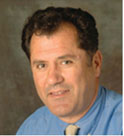Aristidis Veves
NAME Aristidis Veves
PROFESSIONAL TITLE Harvard Medical School Beth Israel Deaconess Medical Center
MOBILE
DESCRIBE I am mainly involved in ‘bench to bedside’ research. My main research field is diabetes and its complications, with the main emphasis on wound healing and cardiovascular disease. Approximately 90 percent of my effort is dedicated to research, 5 percent for teaching and an additional 5 percent for administrative and other relevant professional activities.
RESEARCH FOCUS
I am mainly involved in ‘bench to bedside’ research. My main research field is diabetes and its complications, with the main emphasis on wound healing and cardiovascular disease. Approximately 90 percent of my effort is dedicated to research, 5 percent for teaching and an additional 5 percent for administrative and other relevant professional activities.
Translational research is a major part of my research activities. My work mainly focuses on the interaction between neuropathy and microvascular disease in the development of diabetic foot ulceration and the subsequent impairment of wound healing. This work has been supported by the NIH and nonprofit organizations. I collaborate with investigators from various departments at BIDMC, and investigators from other institutions, such as Brigham and Women's Hospital, to conduct additional translational research.
I conduct investigator-initiated research studies that examine the effects of various FDA-approved medications on cardiovascular function. These studies, although funded by industry, have been conceived, designed, and executed by my unit and focus on possible new mechanisms through which these medications exert their beneficial effects. I have also served as the lead investigator and lead author in industry sponsored multicenter trials that investigated the efficacy of new therapeutic interventions for the management of diabetic foot ulceration.
I also run my own basic research laboratory that mainly explores the findings of this translational research and tries to identify mechanisms underlying the observed results. My laboratory works closely with other laboratories in BIDMC and is funded by NIH grants. I also collaborate with Dr. David Mooney’s laboratory at the Wyss Institute and Harvard Engineering School and Dr. Jonathan Garlick’s at Tufts Medical School. The main aim of our collaboration is the development of new wound-healing products. This collaboration has resulted in NIH funding of our grant applications.
The results of my research have been published in prestigious medical journals, including Lancet, Diabetes, and Circulation. My work, according to Google Scholar as of December 2017, has resulted in more than 17,200 citations an h-index of 67 and i10-index of 149.
I have also been the Director of the Rongxiang Xu, MD, Center for Regenerative Therapeutics since its establishment in December 2015. The center was established after a generous donation from the National Rongxiang Xu Foundation and its mission is to further advance the treatment of patients throughout the world with chronic wounds, burns, and other conditions resulting from a failure of tissue repair and regeneration. As part of its mission, the Center provides resources for the conduction of collaborative bench-to-bedside research with investigators worldwide, as well as the education of physicians and scientists internationally.
SELECTED RESEARCH SUPPORT
Obstructive sleep apnea increases cardiovascular risk in type 2 diabetes; NIH, 2011-2017; Co-PI/Contact PI: Aristidis Veves, PhD, DSc
Role of Macrophages in Impaired Wound Healing in Diabetes; NIH, 2015-2018; Co-PI/Contact PI: Aristidis Veves, MD, DSc
Skin inflammatory phenotypes as biomarkers of myocardial and vascular remodeling; NIH, 2016-2021; Co-PI/Contact PI: Aristidis Veves, MD, DSc
Single cell transcriptome sequencing of diabetic foot skin; Diacomp 2017-2018; PI: Aristidis Veves, MD, DSc
SELECTED PUBLICATIONS
Bai S, Nagai M, Koerner SK, Veves A, Sun L. Structure-activity relationship study and discovery of indazole 3-carboxamides as calcium-release activated calcium channel blockers. Bioorganic & Medicinal Chemistry Letters 2017;27(3):393-397.
Tellechea A, Pradhan-Nabzdyk L, LoGerfo FW, Veves A. Neuropeptides, Inflammation, and Diabetic Wound Healing – lessons from experimental models and human subjects. In: Veves A, Giurini JM, Guzman RJ (Eds). The Diabetic Foot: Medical and Surgical Management (Fourth Edition). Totowa, NJ: Humana Press; In Press.
Zheng Y, Shu B, Fu J, Kafanas A, Veves A. Structural and Functional Changes in Skin of the Diabetic Foot. In: Veves A, Giurini JM, Guzman RJ (Eds). The Diabetic Foot: Medical and Surgical Management (Fourth Edition). Totowa, NJ: Humana Press; In Press.
Roustit M, Loader J, Baltzis B, Zhao W, Veves A. Microvascular changes in the diabetic foot. In: Veves A, Giurini JM, Guzman RJ (Eds). The Diabetic Foot: Medical and Surgical Management (Fourth Edition). Totowa, NJ: Humana Press; In Press.
Loader J, Roustit M, Baltzis B, Veves A. Vascular Dysfunction, Inflammation, and Exercise in Diabetes. In: Reusch JEB, Regensteiner JC, Stewart K, Veves A (Eds). Diabetes and Exercise (Second Edition). Totowa, NJ: Humana Press; 2017, pp 137-150.
Reusch JEB, Regensteiner JC, Stewart K, Veves A. Diabetes and Exercise (Second Edition). Totowa, NJ: Humana Press; October 2017.
Veves A, Giurini JM, Guzman RJ. The Diabetic Foot: Medical and Surgical Management (Fourth Edition). Totowa, NJ: Humana Press; January 2018.


